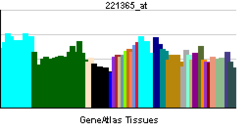- Motilin receptor
-
Motilin receptor Identifiers Symbols MLNR; GPR38; MTLR1 External IDs OMIM: 602885 HomoloGene: 74398 GeneCards: MLNR Gene Gene Ontology Molecular function • receptor activity
• G-protein coupled receptor activity
• growth hormone-releasing hormone receptor activityCellular component • plasma membrane
• plasma membrane
• integral to plasma membraneBiological process • G-protein coupled receptor protein signaling pathway
• digestionSources: Amigo / QuickGO RNA expression pattern 
More reference expression data Orthologs Species Human Mouse Entrez 2862 n/a Ensembl ENSG00000102539 n/a UniProt O43193 n/a RefSeq (mRNA) NM_001507.1 n/a RefSeq (protein) NP_001498.1 n/a Location (UCSC) Chr 13:
49.79 – 49.8 Mbn/a PubMed search [1] n/a Motilin receptor is a G protein-coupled receptor that binds motilin.[1][2] Motilin in turn is an intestinal peptide that stimulates contraction of gut smooth muscle.
References
- ^ Depoortere I (2001). "Motilin and motilin receptors: characterization and functional significance". Verh. K. Acad. Geneeskd. Belg. 63 (6): 511–29. PMID 11813507.
- ^ Yang X, Dong L, Yang H (2006). "[Evidence for the presence of motilin receptor and a study on the mechanism of motilin induced Ca2+ signaling in rat myenteric neurons]" (in Chinese). Sichuan Da Xue Xue Bao Yi Xue Ban 37 (5): 683–6. PMID 17037727.
Further reading
- Smith RG, Leonard R, Bailey AR, et al. (2001). "Growth hormone secretagogue receptor family members and ligands.". Endocrine 14 (1): 9–14. doi:10.1385/ENDO:14:1:009. PMID 11322507.
- McKee KK, Tan CP, Palyha OC, et al. (1998). "Cloning and characterization of two human G protein-coupled receptor genes (GPR38 and GPR39) related to the growth hormone secretagogue and neurotensin receptors.". Genomics 46 (3): 426–34. doi:10.1006/geno.1997.5069. PMID 9441746.
- Feighner SD, Tan CP, McKee KK, et al. (1999). "Receptor for motilin identified in the human gastrointestinal system.". Science 284 (5423): 2184–8. doi:10.1126/science.284.5423.2184. PMID 10381885.
- Miller P, Roy A, St-Pierre S, et al. (2000). "Motilin receptors in the human antrum.". Am. J. Physiol. Gastrointest. Liver Physiol. 278 (1): G18–23. PMID 10644557.
- Thielemans L, Depoortere I, Van Assche G, et al. (2001). "Demonstration of a functional motilin receptor in TE671 cells from human cerebellum.". Brain Res. 895 (1–2): 119–28. doi:10.1016/S0006-8993(01)02055-8. PMID 11259768.
- Coulie B, Matsuura B, Dong M, et al. (2001). "Identification of peptide ligand-binding domains within the human motilin receptor using photoaffinity labeling". J. Biol. Chem. 276 (38): 35518–22. doi:10.1074/jbc.M104489200. PMID 11461914.
- Thielemans L, Depoortere I, Vanden Broeck J, Peeters TL (2002). "The motilin pharmacophore in CHO cells expressing the human motilin receptor". Biochem. Biophys. Res. Commun. 293 (4): 1223–7. doi:10.1016/S0006-291X(02)00356-X. PMID 12054506.
- Depoortere I, Thijs T, Thielemans L, et al. (2003). "Interaction of the growth hormone-releasing peptides ghrelin and growth hormone-releasing peptide-6 with the motilin receptor in the rabbit gastric antrum". J. Pharmacol. Exp. Ther. 305 (2): 660–7. doi:10.1124/jpet.102.047563. PMID 12606621.
- Dunham A, Matthews LH, Burton J, et al. (2004). "The DNA sequence and analysis of human chromosome 13". Nature 428 (6982): 522–8. doi:10.1038/nature02379. PMC 2665288. PMID 15057823. http://www.pubmedcentral.nih.gov/articlerender.fcgi?tool=pmcentrez&artid=2665288.
- Matsuura B, Dong M, Naik S, et al. (2006). "Differential contributions of motilin receptor extracellular domains for peptide and non-peptidyl agonist binding and activity". J. Biol. Chem. 281 (18): 12390–6. doi:10.1074/jbc.M511921200. PMID 16531413.
External links
- "Motilin Receptors: Motilin". IUPHAR Database of Receptors and Ion Channels. International Union of Basic and Clinical Pharmacology. http://www.iuphar-db.org/GPCR/ChapterMenuForward?chapterID=1334.
- MeSH Motilin+receptor

This transmembrane receptor-related article is a stub. You can help Wikipedia by expanding it.
